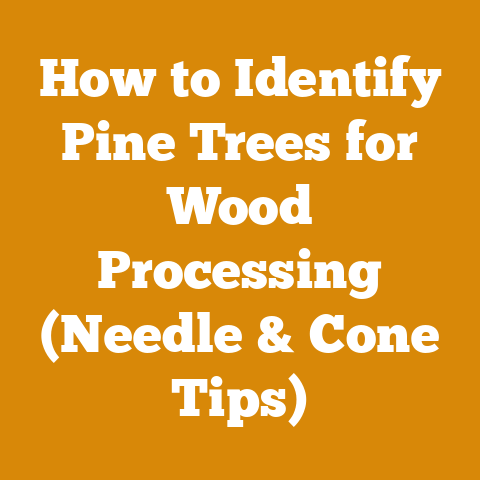Spray for Ground Hornets (Effective Nest Removal Tips for Woodworkers)
The buzzing sound grew louder, closer. It wasn’t the satisfying hum of my chainsaw biting into a seasoned oak log, but a more agitated, menacing drone. I’d been splitting firewood all morning, a rhythmic dance of axe and wood, when I unknowingly disturbed a ground hornet nest. Suddenly, I was under attack. This wasn’t just a minor inconvenience; it was a serious threat, turning my productive day into a painful retreat. Dealing with ground hornets is a reality for many of us who work with wood, whether it’s felling trees in the forest or preparing firewood in our backyards. It’s a situation that demands respect, knowledge, and a well-thought-out plan.
This experience, and others like it over the years, has taught me that effective ground hornet nest removal is crucial, not just for personal safety, but also for maintaining a safe and productive work environment. In this guide, I’ll share my knowledge and experiences, providing you with a step-by-step approach to safely and effectively eliminate these stinging pests from your wood processing areas. We’ll delve into the best sprays, application techniques, preventative measures, and essential safety precautions.
Understanding the Threat: Ground Hornets and Their Nests
Before we grab the spray can, let’s understand what we’re dealing with. “Ground hornets” typically refers to several species of wasps and hornets that build their nests underground. In North America, the bald-faced hornet (Dolichovespula maculata) is a common culprit, though it often builds aerial nests. Yellowjackets (Vespula spp.) are more frequently found nesting in the ground. In Europe, the European hornet (Vespa crabro) is a significant concern. These insects aren’t inherently aggressive, but they will fiercely defend their nest if they feel threatened.
- Identification is Key: Knowing what you’re dealing with is crucial. Yellowjackets are typically smaller than hornets, with distinctive yellow and black markings. Hornets tend to be larger and can have varying color patterns, including white, yellow, and brown.
- Nest Location: Ground hornet nests are often hidden, with only a small entrance hole visible. They can be located in old rodent burrows, under tree roots, or in piles of wood debris – all common in wood processing areas. I’ve even found them nestled under stacks of firewood!
- Activity Patterns: Ground hornets are most active during the day, especially in warmer months. Be particularly vigilant during peak activity hours.
Why are they a problem for woodworkers?
- Proximity: Wood processing often involves working in areas where ground hornets are likely to nest.
- Vibrations: Chainsaws, axes, and other tools create vibrations that can disturb nests, triggering defensive behavior.
- Disturbance: Moving wood piles, digging, or clearing brush can accidentally expose and agitate nests.
Choosing the Right Spray: Insecticide Selection
Selecting the right insecticide is paramount for effective and safe nest removal. Not all sprays are created equal, and using the wrong product can be ineffective or even dangerous.
- Types of Insecticides:
- Aerosol Sprays: These are convenient for direct application into the nest entrance. Look for products specifically labeled for wasps, hornets, and yellowjackets. These often contain pyrethrins or pyrethroids, which are fast-acting neurotoxins for insects.
- Dust Insecticides: These are applied as a powder directly into the nest entrance. The insects then track the dust throughout the nest, spreading the insecticide. Dusts containing carbaryl or fipronil are effective.
- Foaming Insecticides: These expand within the nest, filling the cavities and ensuring contact with the insects. This is a good option for nests with multiple entrances or complex structures.
- Active Ingredients:
- Pyrethrins and Pyrethroids (e.g., Permethrin, Cypermethrin): These are synthetic versions of natural insecticides derived from chrysanthemum flowers. They are fast-acting but can be broken down by sunlight and moisture.
- Carbaryl: A broad-spectrum insecticide that is effective against a wide range of pests. It’s longer-lasting than pyrethrins but also more toxic.
- Fipronil: A slower-acting insecticide that works by disrupting the insect’s central nervous system. It’s highly effective against ants and other social insects, including some ground hornets.
- Considerations When Choosing:
- Toxicity: Always read and follow the label instructions carefully. Choose the least toxic option that is effective for your situation.
- Environmental Impact: Consider the potential impact on beneficial insects and other wildlife. Avoid spraying near water sources or pollinator-friendly plants.
- Nest Location: The location of the nest will influence your choice of insecticide. For nests in enclosed spaces, a foaming insecticide may be the best option. For nests in open areas, a dust insecticide may be more suitable.
- My Personal Recommendations:
- For quick knockdown: I’ve had good success with aerosol sprays containing pyrethrins. They provide immediate relief and are relatively easy to use.
- For long-term control: I prefer dust insecticides containing carbaryl, especially for nests that are difficult to reach or have multiple entrances.
- For large or complex nests: Foaming insecticides are my go-to choice. They penetrate deep into the nest structure and ensure thorough coverage.
Important Note: Always check local regulations regarding the use of insecticides. Some products may be restricted or require a permit.
Step-by-Step Guide to Effective Nest Removal
Now that we’ve covered the basics, let’s get down to the practical steps of removing a ground hornet nest. This is a process that requires careful planning and execution.
Step 1: Preparation and Safety Gear
- Timing is Crucial: The best time to treat a ground hornet nest is at night or early in the morning when the insects are less active and most are inside the nest.
- Protective Gear is Essential: I cannot stress this enough. Wear long sleeves, long pants, gloves, a hat, and eye protection. I also recommend a bee suit or at least a hooded jacket with a mesh face covering. Multiple layers of clothing can help prevent stings.
- Clear the Area: Remove any obstacles around the nest entrance that could impede your access or create a tripping hazard.
- Have an Escape Route: Identify a clear path away from the nest in case you need to retreat quickly.
Step 2: Applying the Insecticide
- Read the Label: Before you even open the can, read and understand the insecticide label. Pay attention to safety precautions, application instructions, and any warnings.
- Approach the Nest Carefully: Move slowly and deliberately to avoid agitating the insects.
- Apply the Insecticide Directly into the Nest Entrance:
- Aerosol Spray: Hold the can close to the entrance and spray a generous amount of insecticide directly into the hole. Continue spraying for several seconds to ensure thorough coverage.
- Dust Insecticide: Use a duster or spoon to apply a layer of dust insecticide around and into the nest entrance.
- Foaming Insecticide: Insert the nozzle into the nest entrance and release the foam. Allow the foam to expand and fill the nest cavity.
- Cover the Entrance (Optional): After applying the insecticide, you can cover the entrance with a rock, dirt, or a piece of plywood to prevent the insects from escaping. However, this is not always necessary and may not be effective if the nest has multiple entrances.
Step 3: Monitoring and Follow-Up
- Observe the Nest: After applying the insecticide, observe the nest from a safe distance. You should see a decrease in insect activity within a few hours.
- Repeat Treatment if Necessary: If you still see significant activity after 24-48 hours, repeat the treatment. Some nests may require multiple applications to completely eliminate the insects.
- Wait Before Removing the Nest: Allow at least a week before attempting to remove the nest. This will ensure that all the insects are dead.
- Remove the Nest (Optional): Removing the nest can help prevent future infestations. However, it’s not always necessary, especially if the nest is located in a difficult-to-reach area.
Case Study: The Firewood Pile Infestation
I once had a severe ground hornet infestation in a large pile of firewood I had stacked for the winter. The nest was located deep within the pile, making it difficult to access. I tried using aerosol sprays, but they were not effective in reaching the entire nest.
I eventually decided to use a combination of dust and foaming insecticides. I first applied a layer of dust insecticide around the entrance to the nest. Then, I used a foaming insecticide to fill the nest cavity. I repeated the treatment a few days later, and within a week, the nest was completely eliminated. I then carefully dismantled the firewood pile, wearing protective gear, and disposed of the remaining nest material.
This experience taught me the importance of using the right insecticide for the specific situation and the value of combining different methods for optimal results.
Preventative Measures: Keeping Ground Hornets Away
Prevention is always better than cure. Here are some steps you can take to reduce the risk of ground hornet infestations in your wood processing areas:
- Maintain a Clean Work Area: Remove wood debris, fallen branches, and other potential nesting materials.
- Fill in Old Rodent Burrows: Ground hornets often nest in abandoned rodent burrows. Filling these in can eliminate potential nesting sites.
- Monitor for Activity: Regularly inspect your work area for signs of ground hornet activity. Look for entrance holes, flying insects, and nests.
- Use Traps: Wasp and hornet traps can help reduce the population of these insects in your area. Place traps strategically around your work area, away from high-traffic areas.
- Consider Natural Repellents: Some natural repellents, such as peppermint oil and citronella, may help deter ground hornets. However, their effectiveness is limited.
- Be Careful When Moving Wood: When moving wood piles or other materials, be aware of the potential for disturbing a nest. Wear protective gear and move slowly and deliberately.
Safety First: Essential Precautions
Working with insecticides and stinging insects requires strict adherence to safety precautions.
- Read and Follow Label Instructions: This is the most important safety precaution. Always read and follow the label instructions carefully.
- Wear Protective Gear: As mentioned earlier, wear long sleeves, long pants, gloves, a hat, and eye protection. A bee suit or hooded jacket with a mesh face covering is highly recommended.
- Work at Night or Early Morning: Ground hornets are less active during these times.
- Have an Escape Route: Identify a clear path away from the nest in case you need to retreat quickly.
- Work with a Partner: If possible, work with a partner who can assist you in case of an emergency.
- Keep Children and Pets Away: Keep children and pets away from the area during and after treatment.
- Be Aware of Allergies: If you are allergic to insect stings, carry an epinephrine auto-injector (EpiPen) and inform your coworkers or family members of your allergy.
- Seek Medical Attention if Stung: If you are stung, monitor yourself for signs of an allergic reaction. Seek medical attention immediately if you experience difficulty breathing, swelling, or dizziness.
- Dispose of Insecticides Properly: Dispose of empty insecticide containers according to label instructions and local regulations.
Beyond the Spray: Alternative Methods (Use with Caution)
While insecticides are often the most effective way to eliminate ground hornet nests, there are some alternative methods that you can consider. However, these methods should be used with caution and are not always as effective as insecticides.
- Boiling Water: Pouring boiling water into the nest entrance can kill the insects. However, this method is not always effective, as the water may not reach all parts of the nest. It can also be dangerous, as you could accidentally spill the water on yourself or others.
- Soapy Water: Mixing dish soap with water and pouring it into the nest entrance can suffocate the insects. This method is less toxic than insecticides but may not be as effective.
- Vacuuming: Using a shop vacuum to suck up the insects can be effective in some cases. However, this method is only suitable for small nests and can be dangerous if the insects escape from the vacuum.
- Relocation: If you are comfortable with the idea, you can attempt to relocate the nest. This involves carefully digging up the nest and moving it to a new location. However, this is a risky procedure and should only be attempted by experienced beekeepers or pest control professionals.
Important Note: I do not recommend using gasoline or other flammable liquids to kill ground hornets. This is extremely dangerous and can cause a fire or explosion.
The Ecological Impact: Considerations for Responsible Pest Control
While eliminating ground hornets from our work areas is often necessary, it’s important to consider the ecological impact of our actions. Insects play a vital role in the ecosystem, and indiscriminate use of insecticides can harm beneficial species.
- Targeted Application: Use insecticides only when necessary and apply them directly to the nest entrance to minimize exposure to other insects and wildlife.
- Choose Less Toxic Options: Opt for insecticides with lower toxicity levels and shorter residual activity.
- Protect Pollinators: Avoid spraying near pollinator-friendly plants and consider using bee-safe insecticides.
- Promote Biodiversity: Create a diverse habitat in your work area to attract beneficial insects that can help control pest populations naturally.
- Consider Integrated Pest Management (IPM): IPM is a holistic approach to pest control that combines various methods, including cultural practices, biological control, and chemical control, to minimize the use of insecticides.
Chainsaws, Axes, and Hornets: A Risky Combination
As a woodworker, I know firsthand the risks of working with chainsaws, axes, and other tools in areas where ground hornets are present. The vibrations and noise from these tools can easily disturb nests, triggering defensive behavior.
- Be Extra Vigilant: When using chainsaws or axes near potential nesting sites, be extra vigilant for signs of ground hornet activity.
- Wear Additional Protection: Consider wearing additional protective gear, such as a full-face shield, when using these tools.
- Take Breaks: Take frequent breaks to rest and assess your surroundings.
- Have a Plan: Develop a plan for what to do if you are attacked by ground hornets.
Log Splitters and Nest Disturbances: Lessons Learned
Log splitters, while incredibly efficient for firewood preparation, can also be a source of nest disturbances. The hydraulic action and the impact of the splitting wedge can transmit vibrations through the ground, alerting nearby hornets.
My Experience: I once had a near-miss while using a hydraulic log splitter. I was splitting a particularly large oak log when I noticed a swarm of yellowjackets erupting from the ground about 10 feet away. I immediately shut down the splitter and retreated to a safe distance. I later discovered that the nest was located under a pile of wood chips near the splitter.
Lessons Learned:
- Clear the Area: Before using a log splitter, clear the area around it of any wood debris or other potential nesting materials.
- Inspect the Ground: Carefully inspect the ground for signs of ground hornet activity.
- Use Vibration Dampening: Consider using a rubber mat or other vibration-dampening material under the log splitter to reduce the transmission of vibrations through the ground.
- Be Prepared to Stop: Be prepared to stop the log splitter immediately if you notice any signs of ground hornet activity.
Firewood Stacking and Hornet Havens: Best Practices
Firewood piles can provide ideal nesting sites for ground hornets. The dark, sheltered environment and the abundance of wood make them attractive to these insects.
Best Practices for Stacking Firewood:
- Stack Firewood Away from Buildings: Stack firewood at least 20 feet away from your house or other buildings to reduce the risk of insects entering your home.
- Elevate the Firewood: Stack firewood on pallets or other platforms to elevate it off the ground. This will improve air circulation and reduce the risk of moisture buildup, which can attract insects.
- Keep Firewood Dry: Cover firewood with a tarp or other waterproof material to keep it dry.
- Inspect Firewood Regularly: Regularly inspect firewood for signs of ground hornet activity.
- Rotate Firewood: Rotate firewood periodically to prevent it from becoming infested with insects.
- Burn Old Firewood First: Burn the oldest firewood first to reduce the risk of insects emerging from the wood.
Drying Wood and Discouraging Hornets: The Connection
Properly drying wood can also help discourage ground hornets from nesting in your firewood piles. Dry wood is less attractive to insects than green wood.
- Seasoning Wood: Seasoning wood involves allowing it to dry naturally over a period of several months or years. This process reduces the moisture content of the wood, making it less attractive to insects.
- Kiln Drying: Kiln drying is a faster method of drying wood that involves using a heated chamber to remove moisture. Kiln-dried wood is typically more expensive than seasoned wood but is also less likely to be infested with insects.
Target Moisture Content: The ideal moisture content for firewood is between 15% and 20%. You can use a moisture meter to check the moisture content of your firewood.
Global Perspectives: Adapting Techniques for Different Climates
Ground hornet infestations are a global problem, and the techniques for dealing with them may need to be adapted for different climates and regions.
- Tropical Climates: In tropical climates, ground hornet nests may be active year-round. It’s important to be vigilant for signs of activity and to take preventative measures to reduce the risk of infestations.
- Temperate Climates: In temperate climates, ground hornet nests are typically active during the warmer months. Treatment is most effective during this time.
- Cold Climates: In cold climates, ground hornets may overwinter in their nests. Treatment is most effective in the fall before the insects go dormant or in the spring after they emerge.
Adapting Techniques:
- Insecticide Selection: The availability of insecticides may vary depending on the region. Choose an insecticide that is approved for use in your area and that is effective against the specific species of ground hornet you are dealing with.
- Protective Gear: The type of protective gear you need may vary depending on the climate. In hot climates, you may need to wear lightweight, breathable clothing to avoid overheating. In cold climates, you may need to wear insulated clothing to stay warm.
- Timing: The best time to treat a ground hornet nest may vary depending on the climate. In hot climates, it’s best to treat nests at night or early in the morning when the insects are less active. In cold climates, it may be necessary to treat nests during the day when the insects are more active.
Cost Analysis: Balancing Effectiveness and Budget
Dealing with ground hornets can be costly, especially if you have a severe infestation. It’s important to balance the effectiveness of your treatment with your budget.
- Insecticide Costs: The cost of insecticides can vary depending on the type of product, the size of the container, and the retailer.
- Protective Gear Costs: The cost of protective gear can also vary depending on the type of equipment you need.
- Professional Pest Control Costs: Hiring a professional pest control company can be expensive, but it may be the best option if you have a large or complex infestation.
Cost-Saving Tips:
- Do-It-Yourself: Treating ground hornet nests yourself can save you money, but it’s important to do it safely and effectively.
- Shop Around: Compare prices from different retailers to find the best deals on insecticides and protective gear.
- Preventative Measures: Taking preventative measures to reduce the risk of infestations can save you money in the long run.
The Future of Ground Hornet Control: Innovations and Research
Research into new and innovative methods of ground hornet control is ongoing. Some promising areas of research include:
- Biological Control: Using natural enemies of ground hornets, such as parasitic wasps or nematodes, to control their populations.
- Pheromone Traps: Using pheromones to attract ground hornets to traps.
- RNA Interference (RNAi): Using RNAi technology to disrupt the genes of ground hornets, preventing them from reproducing.
These new technologies hold promise for more effective and environmentally friendly methods of ground hornet control in the future.
Final Thoughts: Respect the Buzz, Protect Yourself
Dealing with ground hornets is a challenge that many of us who work with wood will face at some point. By understanding the threat, choosing the right tools, following safety precautions, and taking preventative measures, we can minimize the risk of stings and maintain a safe and productive work environment.
Remember, respect the buzz. Ground hornets are an important part of the ecosystem, but they can also be dangerous. By following the advice in this guide, you can protect yourself and your property from these stinging pests.
Now that you’re armed with this knowledge, take a walk around your wood processing area. Look for potential nesting sites, clear away debris, and be prepared to take action if you find a ground hornet nest. Your safety and the safety of those around you depend on it. Good luck, and stay sting-free!






